Transactions in G-secs Market through NDS and NDS-OM - ربی - Reserve Bank of India
Transactions in G-secs Market through NDS and NDS-OM
Till 2002, the Government securities market was mainly a telephone market. Buyers and sellers traded over telephone and submitted physical Subsidiary General Ledger (SGL) transfer forms for transfer of the Government securities and cheques for settlement of the funds to the Reserve Bank of India. These manual operations were inefficient and often resulted in delays. In order to improve efficiency in the market, the Reserve Bank of India took steps to automate the process of trading and settlement of Government securities transactions and the Negotiated Dealing System (NDS) was introduced in February 2002. The Negotiated Dealing System (NDS) has two modules – one for the primary market and the other for the secondary market. I. Primary Market Module The Reserve Bank uses the primary auction platform (NDS Auction) for auction of both, dated securities of the Government of India and the State Governments as also, treasury bills. This platform allows participants to electronically submit their bids in the primary auctions and receive allotment reports. Main features of the auction platform are:
II. Secondary Market Module Secondary market trading in Government securities can happen over-the-counter (OTC). These trades generally happen over phone. Players are required to report secondary market trades on the NDS. Once they complete the reporting process and the system accepts trades, the data automatically flows to the Clearing Corporation of India Ltd. (CCIL) for clearing and settlement (See box for CCIL). This avoids paper based settlement process. Paper based system required participants to exchange subsidiary general ledger (SGL) forms for transfer of securities and cheques for transfer of funds. The details of the trades reported on NDS are disseminated through the RBI web site /en/web/rbiScripts/NdsUserXsl. aspx
NDS-OM The Reserve Bank introduced the Negotiated Dealing System-Order Matching system or NDS-OM as it is called, in August 2005. The NDS-OM is an electronic, screen based, anonymous, order driven trading system for dealing in Government securities. The Reserve Bank owns NDS-OM and CCIL maintains it. The platform is in addition to the existing facility of over-the-counter (OTC) or phone market in Government securities. The NDS-OM brings transparency in secondary market transactions in Government securities. Members can place bids (buy orders) and offers (sell orders) directly on the NDS-OM screen. Being order driven, the system matches all bids and offers on price/time priority, that is, within the orders of the same price, it matches the oldest order first. The system ensures complete anonymity among the participants as CCIL acts as the central counter party (CCP) for settlement of all the trades. The NDS-OM also facilitates straight-through-processing (STP), that is, all the trades on the system are automatically sent to the CCIL for settlement. With the efficiency and ease of its operations, the NDS-OM has today captured over 80 per cent of the trading volume in Government securities. The trade details of NDS-OM are disseminated through the CCIL’s website http://www.ccilindia.com/OMHome.aspx. Only authorised users of the member entities can log in to the system. Participants There are two kinds of participants in NDS-OM – direct and indirect. Direct members have current and SGL accounts with the Reserve Bank and can directly settle their trades on NDS-OM. Indirect members are those players who do not have current and SGL accounts with the Reserve Bank and therefore have to trade on NDS-OM through members who have these accounts with the Reserve Bank. All resident entities, including corporates but excluding individuals, can access NDS-OM, either directly or indirectly. Foreign institutional investors (FIIs) have been provided indirect access. More specifically, currently banks, including state cooperative banks, primary dealers (PDs), insurance companies, mutual funds and larger provident funds have current and SGL accounts with the Reserve Bank and therefore can directly trade on NDS-OM. Qualified entities, such as, non-banking finance companies(NBFCs), smaller provident funds, pension funds, cooperative banks, regional rural banks and trusts, corporates and FIIs do not have current and SGL accounts with the Reserve Bank and therefore can only indirectly, that is, through banks and PDs, trade on NDS-OM. Banks and PDs provide custodial services to indirect members by opening their securities and funds accounts. Indirect members can place orders through their custodian using client accounts. Such trades would finally settle through the Constituent SGL (CSGL) account and current account of the custodian who is a direct member. NDS-OM currently has direct membership from more than 130 financial institutions.
Who can be a member of NDS-OM? Following are the prerequisites of obtaining membership of the NDS-OM:
* Entities such as mutual funds and insurance companies, which are not eligible to open current account with the Reserve Bank, need to open a funds account with one of the Designated Settlement Banks (DSBs) appointed by CCIL for settlements. Why trade on NDS-OM?
Features of NDS-OM While there are a host of features for operational ease and better security, the following are the major ones. (i) Market watch Market watch is the first page of NDS-OM once the user logs in to the system. The page gives securitywise details, current state of the market by giving details like best bid, best offer, last traded price and yield and total traded amount on real time basis for each security. Market watch is separately available for different segments of the market, viz., Central Government securities (CG), State Government securities (SG), Treasury bills (TB), Odd lot market (OD) and When Issued market (WI). From the market watch page, the user can navigate and drill down to security level prices/ yields of the bids and offers available in the system. The ‘orders by price’ link gives ten best prices for a security on bid and offer side. It also shows the depth of the market by giving the total number and amount of bids and offers for each security. The market watch of NDS-OM is also available on CCIL’s website at http://www.ccilindia.com/OMHome.aspx 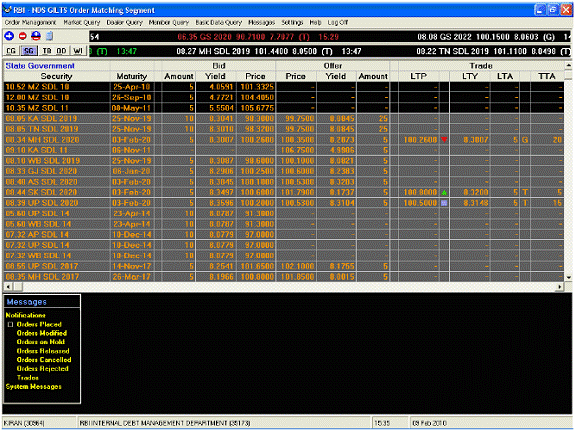 (ii) Placing orders (bids/offers) Bids are placed by clicking on the ‘place bid’ icon on the screen or could be placed by double clicking the best offer on the market watch page. Similarly offer could be placed by double clicking the best bid available on the market watch page. 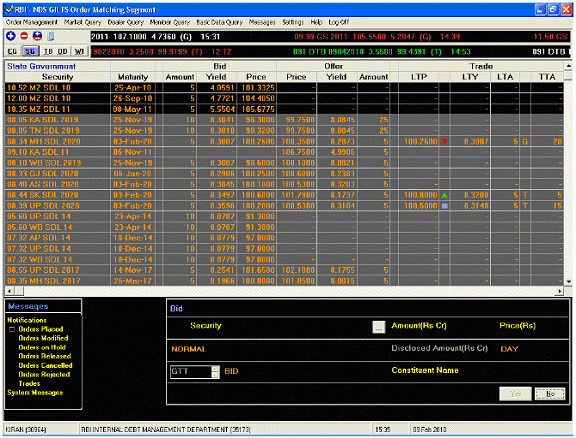
(iii) Order confirmation Once the details of the order are filled in (see screen shot above) and submitted, details of the order are shown once again by the system (see screen shot below). Only after confirmation, the order gets placed in the system. 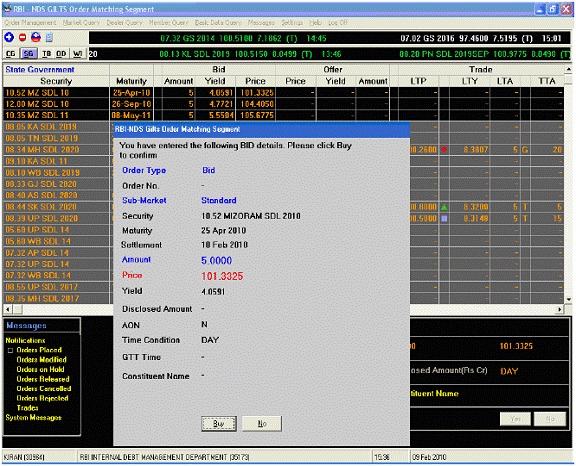 (iv) Modify/cancel bids Orders placed on NDS-OM can be modified or cancelled at any time before they get matched. This helps the member to update the order placed according to the price movements. Further, facility is also available to cancel all orders/ all buy orders/ all sell orders/ a particular order at a time depending on the requirement of the participant. (v) Odd lot To facilitate trading in smaller lot sizes by retail investors, a separate segment has been created in NDS-OM in which the minimum trading lot is Rs.10,000. This will facilitate smaller players like cooperative banks, provident funds and other financial institutions to trade in lot sizes that are less than Rs.5 crore. Since the prices are transparent and the platform provides anonymous trading, the interest of the small players is well protected. (vi) ‘When Issued’ trading ‘When, as and if issued’ (commonly known as ‘When-Issued’ (WI)) trading takes place between the time auction of a security is announced and the time it is actually issued. When issued or ‘WI’ security refers to a security that has been authorised for issuance but is not yet actually issued. All 'When Issued' transactions are on 'if' basis, that is, they are to be settled if and when the actual security is issued. Trading in ‘When Issued’ market is exclusively permitted only on NDS-OM. This helps price discovery of the securities being auctioned as well as the smooth distribution of the stock of securities that will be auctioned. (vii) Market enquiry During the day, market enquiry will show details like the day’s high, low, last and weighted average yield and price and the previous day close for any selected security. 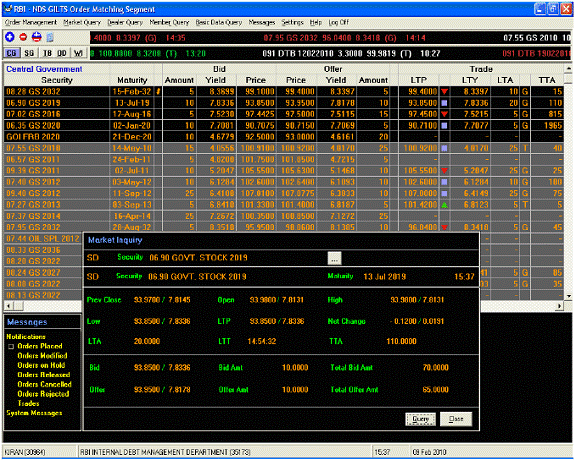 (viii) Reports Various reports can be generated on NDS-OM by users, as detailed below;
Settlement of deals on NDS-OM 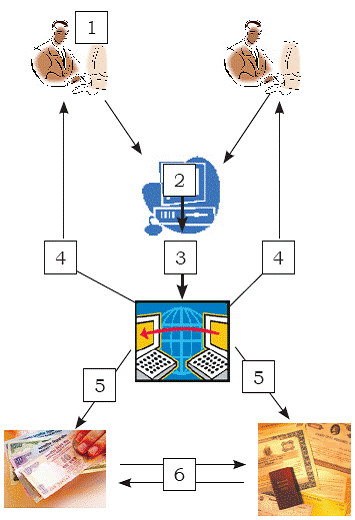
Useful links
|






















